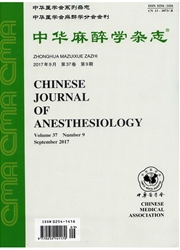

 中文摘要:
中文摘要:
目的探讨骨癌痛大鼠背根神经节酸感受离子通道3(ASIC3)表达的变化。方法雌性SD大鼠24只,3~4周龄,体重180—220g,采用随机数字表法,将大鼠随机分为2组:假手术组(s组,n=8)和骨癌痛组(P组,n=16)。P组于左侧胫骨骨髓腔内注射5μl Walker256肿瘤细胞制备骨癌痛模型,s组注射生理盐水5μl。分别于接种当天(T0)和接种后1、3、5、7、9、11、14d(T1-1)时,称量大鼠体重,测定机械痛阈。s组于T7时,P组于T4、T7时,取大鼠胫骨,行病理学检查和影像学检查,观察肿瘤细胞的生长和骨质破坏状况,采用免疫荧光法测定背根神经节ASIC3的表达。结果P组骨髓腔内出现了肿瘤细胞浸润,胫骨发生病理学损伤,胫骨破坏明显,多处骨皮质缺失。与s组比较,P组T3—T7时体重降低,T4-T3时机械痛阈降低,T7时背根神经节ASIC3表达上调(P〈0.05)。结论骨癌痛大鼠背根神经节ASIC3表达上调,提示该通道可能参与骨癌痛的病理生理机制。
 英文摘要:
英文摘要:
Objective To investigate the changes in the expression of acid-sensing ion channel 3 (ASIC3) in the dorsal root ganglion (DRG) in a rat model of bone cancer pain. Methods Twenty-four female SpragueDawley rats, aged 3-4 weeks, weighing 180-220 g, were randomized into 2 groups: sham operation group (group S, n = 8) and bone cancer pain group (group P, n = 16). Bone cancer pain was induced by inoculating Walker 256 carcinoma cells into the medullary cavity of the left tibia, while group S received normal saline instead. The pain threshold was measured after determination of body weight on the day of inoculation (T0) and on 1, 3, 5, 7, 9, 11 and 14 days after inoculation (T1-7). The tibia was removed for microscopic examination of the inoculated tibia and X-ray examination. The growth of tumor cells and damage to the tibia were observed. The expression of ASIC3 in the DRG was detected using Results The tumor cell infiltration occurred in the medullary cavity and bone destruction was observed in P group. Compared with S group, the body weight was decreased at T3-T7, and the pain threshold was decreased at T4-T7, and the expression of ASIC3 in the DRG was up regulated at T7 in P group ( P 〈 0.05). Conclusion ASIC3 protein expression in DRG is significantly up-regulated in the rats with bone cancer pain, suggesting that the pathway may be involved in the mechanism of bone cancer pain.
 同期刊论文项目
同期刊论文项目
 同项目期刊论文
同项目期刊论文
 期刊信息
期刊信息
